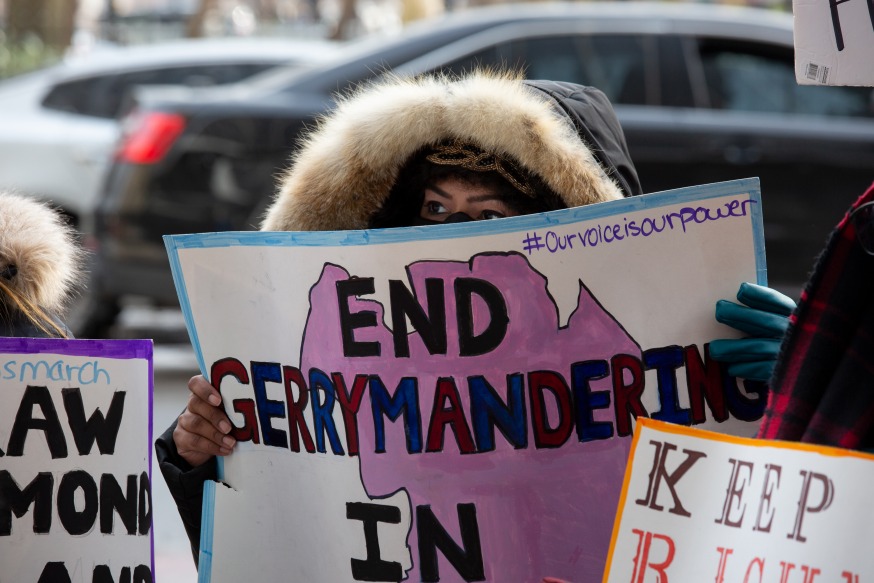
A voting-rights activist protested near City Hall about proposed redistricting in Queens, Jan. 31, 2022. | Ben Fractenberg/THE CITY
 This article was originally published by The CITY on Feb. 1
This article was originally published by The CITY on Feb. 1
New York City is slated to get more representation in the state Legislature under a redistricting proposal unveiled late Monday night, shifting two out of 63 State Senate seats to the five boroughs and amplifying the power of Asian and Hispanic voters.
The legislative measure, expected to be approved by the Democratic-dominated State Senate and Assembly later this week, adds a district in Brooklyn that’s plurality Asian and another in Queens that’s largely Hispanic, reflecting New York City’s population and demographic shifts over the past decade.
The changes to the district boundaries, which follow the decennial census, reapportion the two new districts from upstate, where population growth lagged. The changes are necessary to rectify lines Republicans drew a decade ago when they controlled the Senate, Democrats argue.
“The important thing to realize is New York is a deep blue state, we all know this. It’s well known nationally,” State Sen. Michael Gianaris (D-Queens), the second-highest ranking member of the chamber, on WNYC’s Brian Lehrer Show Tuesday. “So it shouldn’t be a surprise that when maps are done fairly there’s going to be a result that reflects that reality on the ground.”
As proposed by the Legislative Task Force on Demographic Research and Reapportionment (LATFOR), District 17 combines areas currently represented by several lawmakers and extends from Greenpoint and Long Island City in the west through portions of Sunnyside, Maspeth, Glendale, Woodhaven and Richmond Hill. Meanwhile, the district with a plurality of Asian New Yorkers would capture Windsor Terrace, Sunset Park’s Chinatown, Bensonhurst and a sliver of Gravesend.
Both districts skew heavily Democratic, with voters overwhelmingly casting their ballot for President Joe Biden in 2020, likely ensuring that Democrats will secure those seats in November and retain their advantage in the State Senate for years to come.
State lawmakers will also be voting on new Assembly maps, where boundaries will change less dramatically because Democrats also drew them in the last redistricting a decade ago.
‘Not Over ’Til It’s Over’
The proposed Senate and Assembly district lines follow new congressional maps unveiled over the weekend. New York’s proposed federal districts largely protect the city’s sitting representatives while jeopardizing the delegation’s lone Republican, Rep. Nicole Malliotakis, as Democrats nationally hold a razor-thin margin in the House.
At a news conference in The Bronx Tuesday, Gov. Kathy Hochul said she would review the newly drawn maps once the legislature approves them — seizing on a sense of urgency to enact the maps quickly after a bi-partisan commission charged with presenting state lawmakers a unified proposal failed to do so.
“As someone who’s had some experience with this, the candidates also need to know certainty as soon as possible. They need to know the lines so they can make a decision: Do they run, do they not run? What is involved there because the elections are really just a few months away,” said Hochul, a former one-term member of Congress from Buffalo.
With the state and federal primaries scheduled to take place in late June, elected officials and challengers need to begin collecting signatures to run for office next month.
Hochul did not comment on accusations from Republicans and some good-government watchdogs that Democrats drew the maps to favor their party, a phenomenon known as gerrymandering, but noted that the process “is not over ’til it’s over.”
“There’s still time for more conversations and back and forth,” she said. “So I will wait to see what is presented to me on my desk at such time. I just really want this process to keep moving forward. We need the certainty, the clarity. Time is slipping away quickly.”
Republican Minority Leader Rob Ortt, in a statement, warned that a lawsuit challenging the new boundaries would be imminent.
“By drawing their own partisan maps, Democrats in the Legislature are ignoring the will and testimony of hundreds of thousands of New Yorkers — all to protect and enhance their own political power,” said the western New York lawmaker. “Democrats’ closed door map making is a shameless, partisan example of gerrymandering at its worst.”
Advocates See Room to Improve
Redistricting advocates who spoke to THE CITY opined that some proposed districts united ethnic groups in Brooklyn and Queens into potentially powerful voting blocs, but emphasized that there were still many missed opportunities.
In Brooklyn, where the Asian-American population grew by 43% in the past decade, parts of Sunset Park with a large number of Asian residents are currently cut up into three separate Senate districts. But LATFOR drew a Senate district with a plurality of Asian residents instead.
Advocates said it was a step forward, but added that by excluding Bath Beach from the district, Albany politicians missed out on an opportunity to create the first Asian-majority Senate district.
“That district with the current LATFOR plan would bring the total Asian population to 46%, so that’s short of the Asian majority that we’re looking for,” said Mon Yuck Yu, executive vice president of Sunset Park’s Academy of Medical and Public Health Services. “We’re happy that LATFOR was able to consider the proposed map configuration to have this brand new Senate district in Sunset Park, but we’re disappointed that we aren’t able to obtain that Asian-majority Senate district that we’ve been hoping for in south Brooklyn.”
Meanwhile, advocacy groups in Queens expressed disappointment that South Asian and Indo-Caribbean populations weren’t united into single districts. One district leader lamented the break up of the 10th Senate District, which contains Richmond Hill and South Ozone Park, into three districts.
“These maps by State Democrats will perpetuate harm to South Asian and Indo-Caribbean residents who have called South Queens home since the 1960s — for at least another decade, and another generation,” said Richard Davis, a district leader for Queens’ 31st Assembly District. “It’s heartbreaking to see these maps after so many people and organizations testified for these areas to be kept united.”

Ben Fractenberg/THE CITY Redistricting protest at City Hall Monday.
Still, one bright spot for redistricting advocates is the new 30th Assembly district in Queens, which would be roughly 50% Asian. The new district brings together many different parts of the borough’s Asian diaspora by including parts of Elmhurst, Woodside’s Little Manila and East Elmhurst.
“This is going to be the most diverse Asian district in, if not just the state, but maybe in the country,” said Jagpreet Singh, the political director of Desis Rising Up and Moving (DRUM).
Redistricting advocates still contend that the collapse of the state’s independent redistricting commission signals a need for politicians to reform the process via the state constitution in time for the 2030 redistricting cycle.
“We need to redesign the independent commission or start over and have an independent body that has decision making power and that’s designed to actually be nonpartisan and responsive to community needs,” said Asher Ross with the New York Immigration Coalition.
THE CITY is an independent, nonprofit news outlet dedicated to hard-hitting reporting that serves the people of New York.
